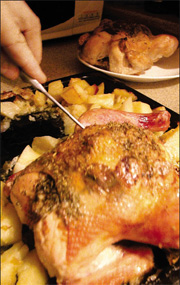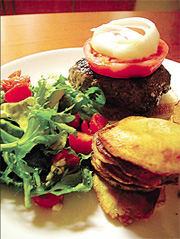A restaurant that’s very close to home

Roast chicken stuffed with sausage, chestnuts, garlic and herbs.
However, this is Seoul. There are no English restaurants here. There are Irish bars, which serve dishes some regard as English, but many include Guinness as an ingredient and that makes them irredeemably Irish.
The only way to rise to the demands of my stomach, and the challenge of providing my fiancee with English grub, prior to an upcoming visit to the homeland, was to turn my apartment into a restaurant serving the aforementioned cuisine.
There had to be some rules. All the food had to be in my possession, or purchased from the estimable WellBeing Mart at the bottom of the hill, all dishes had to be easy to reproduce and all the food had to be presented in the style of a first-class restaurant.
The first issue was which dish to make. Some would say the answer should be chicken tikka masala. This delicacy from India, Britain’s former colony, is now eaten more frequently in England than any other dish, including fish and chips. In terms of geopolitical gastronomy this is akin to Japan adopting bulgogi and kimchi as their national foods.
However, I am more of a traditionalist. I decided to make an English chicken roast and I opted to supplement this with a steak cooked in the English style.
I set off for WellBeing mart in an optimistic frame of mind. I had found English sausages in the refrigerator, previously purchased from Shinsegae. These are the vital ingredient for the chicken’s stuffing.
All I needed now was chicken. At the market, the only poultry on offer were some skinny specimens of the sort that are called “Cornish hens” in the U.K. ― here they are used for Samgyetang. No matter. I bought two, to make up for their lack of girth. They cost 3,900 won each ($4.32).
Although meat is ridiculously expensive in Korea, vegetables are relatively cheap, of good quality and available in many different varieties.
For my two dishes I bought a bag of 40 mushrooms for 2,000 won , some Romaine lettuce for 1,000 won, eight onions for 3,300 won and a melange of aubergines, Brussels sprouts, carrots, zucchini, tomatoes, chestnuts and garlic for less than 15,000 won in total. I also picked up goat’s cheese and some ham for 12,000 won.
“The importance of fresh ingredients cannot be overestimated,” said Chef Susumu Yonaguni at OKitchen in Gahoe-dong, whom I consulted with in order to prepare a restaurant-style meal at home. “And you need good ambience and presentation.”
Back home, my first task was to stuff the chicken, which were certainly not built on the scale of Henry VIII’s swans. No matter. The meat looked succulent enough and the purpose of a good stuffing, apart from being a joy to eat, is to preserve the delicate texture of the young meat.
I carefully prized open the skin from the neck end, being careful not to make any rips. Once the skin was away from the breast meat I inserted my stuffing. This had been made by mixing herbs, chestnuts, sausage meat, crushed garlic, chopped onions and sauteed mushrooms. As the chicken cooks, the stuffing drips moisture and flavor into the breast meat and it also helps the skin to turn crisp and brown.
Potatoes are a vital ingredient of traditional English food but we don’t like them macerated in a stew or soup. We prefer them roasted in oil or fried. I had decided to prepare both sorts. For the roast variety, I peeled the spuds and chopped them into cubes that were about the size of an orange segment. These were tossed into boiling water for ten minutes then drained and arranged around the chickens in a roasting pan.
One of the glories of English food is that once the preparation has been done there is time for relaxation while the kitchen fills with delicious aromas. On this occasion I had to forgo this in order to turn my dining area into a simulacrum of a fine dining restaurant. The answer lay in candles, a polished wood table and dishes laid out in balance with cutlery.
By now the birds were well advanced. According to Gordon Ramsay, one of England’s most famous celebrity chefs, Brussels sprouts are a key element in a good roast. I made my version by boiling them for five minutes and them tossing them with mushrooms, bacon and sherry.
As I awaited the completion of the chickens, I set about making the fried potatoes. Chef Yonaguni had told me to cut the potatoes into very thin slices and fry them twice in extra virgin olive oil. The results were spectacular. I almost ate the whole of the first batch and had to cut some more potatoes in order to continue. After the first cooking I sprinkled the potatoes with salt, which did amazing things to the taste during the second fry up.
I took the chickens out of the oven and removed them from the pan to rest. This is essential to let the juices spread back through the meat. The potatoes went back in for a final crisping, with the steak cooking on a piece of foil in their midst so the beef could benefit from the chicken juices.
As an appetizer I put a slice of tomato, some goat’s cheese and ham on toast and warmed this through in the oven.
In serving the food I followed Chef Yonaguni’s advice and stacked everything in little piles. These architectural wonders keep the food compact and also helps to intensify the aroma when the dishes are served.
I was pleased with the results. I had used a Korean store to prepare a series of quintessentially English dishes. Maybe somebody will now follow my example and ― don’t laugh ― open Seoul’s first English restaurant.

English steak with fries in an architectural arrangement. By Ko Juran










with the Korea JoongAng Daily
To write comments, please log in to one of the accounts.
Standards Board Policy (0/250자)